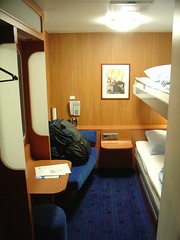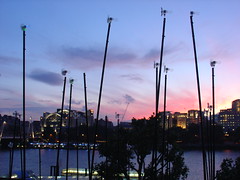Knowing I would be leaving for Rome later in the day, I set my expectations low: il Duomo and one museum (of course, soaking up as much ambiance as possible).
For breakfast I stopped by a small market, which I later found was unnecessary: plenty of places in Florence have cheap breakfast. Though the upside of eating market food is you run into other vagabonds on the street trying to find a place to sit and eat. At the entrance to one of the bridges I met Tara and Mallory. They happened to be eating a similar breakfast and we also shared a similar pace when it came to our city-hopping rate. The main danger with the side of the road in Florence is due to the buses: when they turn the corner you are certain you will lose your legs and be crushed. Fortunately the turning radius is wider than they initially let on.
Walking to il Duomo I remember best the smell of leather from all the tourist hungry street vendors. At the Dome itself I remember best all the tourists with their cameras, taking the same picture. I got in line to walk the 450+ stairs to the top and thought about this second impression some more.
I think we need a philosophy of travel, in the same way we have a philosophy of science. There are some really pressing questions worth asking:
- What does it mean to be a tourist?
- Why do we disdain "touristy" place, and what makes them that way?
- Why travel at all?
- Is it worth taking a photo when it has been taking so many times before?
- At the end of our travels, what are we left with?
I think these questions first came to me in Paris, seeing crowds around the Mona Lisa and playing "spot the tourist" with Pierre (perhaps I was under the influence of some existential philosopher's ghost). But waiting in the long line to il Duomo I had some more time to reflect. I'll pepper these entries with "answers" to these questions as I dream them up.
The path up the Dome is really confusing. There are plenty of circular staircases, but it stops intermittently for longer hallways and right angles. Then, halfway up, you circle the base of the dome itself and follow an even more confusing path with slanted walls, narrow hallways, and steep stairs. I liked how the brick layers had to adopt unusual diagonal patterns to create the actual dome.
At the very top you step into the sunlight, which is the best part. Especially feeling the wind at the top on a hot dry day. I'm pretty sure it's the highest point in Florence, you can see everything (anything more than a block away). That was my simple lesson from the dome: when you're on top of something big, it can be hard to see the things nearby. I sat up there for maybe twenty minutes appreciating the view of the city.
After descending, because it was so hot and water wasn't cutting it, I had my first Gelato in Italy. It was a piccolo limone from this crazily lit place called "Festival del Gelato".
Walking around afterwards, browsing the windows of stores on main streets, I made some notes on what binds Western culture (as best I could tell from the cities I'd visited): food, materialism (more pronounced in America than Europe), and Harry Potter. The last book was released while I was in Lyon, and it seemed like everyone was advertising it.
Not meaning to, I found Luggia di Lanzi — a semi-enclosed square adjacent to a large piazza. It was filled with wonderful sculpture, and since it's Florence these weren't just any sculptures but most were second century AD. I get the impression that the city is overflowing with art.
I walked next to the "Firenze Mvsei", containing the Palatine gallery and modern art gallery (amongst others). Since I was in Florence just to be ironic I went to the Modern Art gallery first. There was a great exhibition with all these dresses and concept art for modern theater. The Palatine gallery had a ton of Florentine and related art, mostly paintings.
There were plaques with descriptions to introduce each of the rooms, and as the end of the 19th century approached they started a big discussion about the role of "reality" in art. I had an idea for a manifesto a few days earlier that dealt with this issue. It would say something about the futility of attempting to capture "reality" in art — whether with photography or film or anything. There is an illusion that photography captures reality better than painting, and that film captures reality better than photography (film with sound more so). In fact the "reality" we're trying to capture is a subjective experience, and not until we can record and induce those experiences directly will we be able to capture "reality". In the meantime, anything goes. Any sense pairings and content pairings. I'm not saying that any of this would be pleasant, just that's it's all equally "real" — which is to say, it's not "real" at all.
The other thing the Palatine gallery reminded me was how little I know about any city I've gone to, and how little I know about art especially. I think it's best for me to play critic and philosopher rather than historian.
From the museum I went back to the train station, where I picked up my backpack and got on the train to Rome. There was some sort of movie being filmed on the platform so I had to walk around the crew. No actors I knew, just an Asian girl that was strolling in and out of the shot, waiting for "action".
From the first moment off the train I could tell things moved quickly in Rome. At the end of the platform I met the endlessly kind Giovanni Giametta, a friend of my uncle's. We walked to his car and raced off to the hotel he'd booked for me through an old friend from Boy scouts. The hotel was once a cathedral and monastery that had only recently been renovated.
In Florence I had first hand experience of the fabled Italian driving, and was cautious when Giovanni first launched out of the parking lot, but once we got to the traffic everything instantly made sense. There is a "flow" to Italian driving that's hard to see from the sidewalk. There is a reason there aren't many lines painted on the Italian streets: the lanes are created and destroyed on the fly, everyone adapting to the situation at hand. It's like they've transcended the need for certain road regulations by acknowledging that any rule has limited use, and the road is far too complex to impose a single standard on (or maybe they're all just equally crazy). They tend to stay on the right and stop at major lights, but besides that most everything is fair game. Giovanni added, as I mentioned these things to him, that it would be nice if they had something like in America at four way stops for determining the order.
From the hotel we went to Giovanni's house (really a multi-building mini-villa near the main park in North Rome) to visit his wife and some family. On the road I was thinking about how fast Rome seemed, faster even than New York City. But sitting down for a few minutes outdoors at his place — this is when I realized Rome is slower as well. Or at least it can be.
Giovanni took me out to a very nice restaurant called "Scala", his "kitchen away from home". Everyone knows him there, and they managed to find us a table even though they were "full". This kind of social engineering always amazes me. We had some great appetizers, then an octopus pasta I really liked (but Giovanni thought was "eh"). I'm also not the best judge of food on as an empty-stomached traveller. We finished with a pasta Giovanni recommended, which was tasty as well but seemed very simple. Then again, the best always seems effortless (whether it's an Olympic athlete pulling off some maneuver or a chef preparing a dish).
We discussed a variety of topics over dinner, from the Italian character to the graffiti problem in Rome to a little stand on the corner of the street that's become famous for a single drink. After dinner he took me to the stand, where they serve "Lemon Coco". It's basically just southern Italian lemons squeezed and mixed with sugar water and coconut juice. Possibly one of the most refreshing drinks ever.
We went back to his house and I tried speaking half Spanish and half English with his wife while he sorted out something else. When he was done he took me on a whirlwind evening tour of Rome — the Colosseum, Roman Forum, the view from the Spanish embassy, the Vatican, etc. Around ten the traffic got worse and my full stomach was getting the best of me, so we called it an evening. I gladly crashed on the huge hotel bed, a very welcome alternative to the hostels I'd been staying at up to this point.





